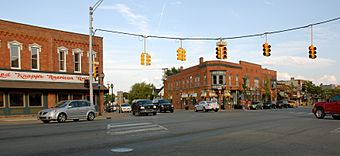Oxford Downtown Historic District facts for kids
Quick facts for kids |
|
|
Oxford Downtown Historic District
|
|

The intersection of Washington and Burdick
|
|
| Location | Washington St./MI-24 and Burdick St., Oxford, Michigan |
|---|---|
| Built | 1876 |
| Architect | Charles A. Fisher and William J. Fisher |
| Architectural style | Victorian, Italianate, Queen Anne, and other |
| NRHP reference No. | 100004158 |
| Added to NRHP | July 15, 2019 |
The Oxford Downtown Historic District is a special area in Oxford, Michigan. It's a historic part of the town's main street, Washington Street, right where it meets Burdick Street. This district is important because it shows what downtown Oxford looked like a long time ago. In 2019, it was added to the National Register of Historic Places, which means it's recognized as a place with a lot of history!
Contents
A Look Back: Oxford's Downtown History
Imagine Oxford way back in 1839. That's when the first post office opened right at the corner of Washington and Burdick Streets. A few years later, in 1842, the very first store opened its doors. Soon, more wooden buildings popped up in the downtown area.
In 1845, the village was officially mapped out. By the mid-1800s, Oxford was growing fast! By 1856, there were 26 businesses in the downtown area. After the American Civil War, even more growth happened. A railroad line came through the village in 1872, making it easier for people and goods to travel.
As the town kept growing, fires sometimes destroyed the older wooden buildings. But people quickly rebuilt them, often using strong brick. Many of the buildings you see in the district today were built between 1880 and 1899. By 1897, about 1,200 people lived in Oxford. The town's main income came from the farms around it, but smaller businesses like gravel mining also helped the economy.
Changes Over Time
In the 1900s, Oxford continued to develop. In 1915, Washington Street became a major state road. This meant more cars started driving through Oxford. Businesses changed to offer car sales and service.
Big events like the Great Depression and changes after World War II also affected Oxford. More chain stores started appearing, and as more people moved to the areas around Oxford, the downtown had to adapt. In the 1960s and 1970s, some older buildings were taken down to make space for parking lots or new buildings. Even with these changes, downtown Oxford is still a busy and important center in Oakland County.
What You'll See: The Downtown District
The Oxford Downtown Historic District covers two blocks of Washington Street, with Burdick Street in the middle. It also includes two buildings on Burdick Street near the main intersection. In total, there are 44 buildings and structures in the district. Thirty-four of these are considered "historic," meaning they help tell the story of the area.
Most of the buildings were used for businesses, but some were once used for community groups or government offices. They are usually one to three stories tall. You can see many different building styles here, like Italianate, Queen Anne, Neoclassical, Art Deco, and Colonial Revival. More than half of the buildings were built in the late 1800s. The rest were mostly built between 1900 and 1922.
Images for kids











